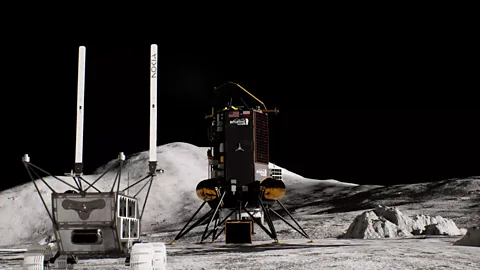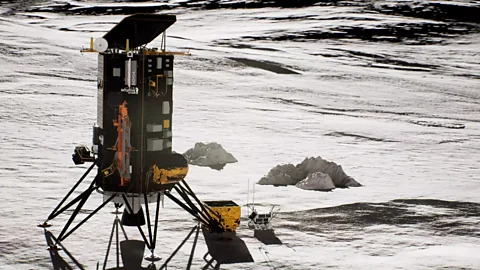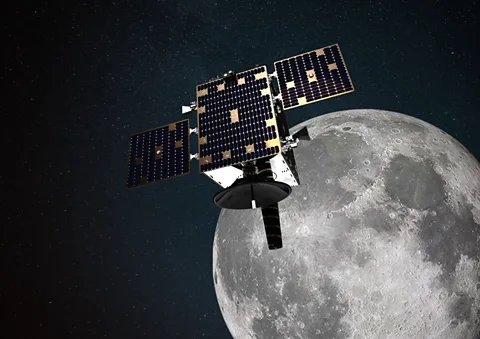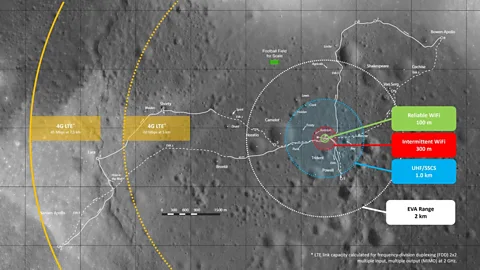Talking on the Moon: The quest to establish a lunar mobile phone network
 Nokia
NokiaThe Apollo astronauts' links to Earth were primitive compared to those we enjoy today. The next generation of moonwalkers may have a far more high-resolution way of keeping in touch – both with each other, and with us back on Earth.
On 20 July 1969 an estimated 600 million people watched a live broadcast that was both out of focus and of extremely poor quality.
The historic nature of the first human walking on the Moon – part of Nasa’s Apollo 11 mission – naturally overshadowed the technicalities. But today's global audiences take high-definition live streaming for granted and, for the next generation of lunar astronauts, expectations will be much higher.
"No one is going to accept the Apollo video quality," says Matt Cosby, chief technology officer at the UK’s Goonhilly Earth Station, which communicates with satellites and spacecraft.
Goonhilly broadcast the Moon landing's television signal around the world and recently received the first signal from Intuitive Machines' Odysseus craft, confirming the US's first soft-landing on lunar soil in more than 50 years.
"We will expect 4K resolution from the Moon almost in real time coming from the landing. It's going to be up to 500 megabits of data coming back so the images are going to be 10 times better," says Cosby.
"In this day and age, and with social media, grainy black and white photos and videos from the Moon's surface will be unacceptable and we need to get the higher frequencies to be able to do that. It's not a huge leap but it needs to be made. It's all about investment."
 Nokia
NokiaThat investment is underway globally. Between 2021-23 Nasa's LunarLites project, at its Glenn Research Centre in Ohio, evaluated how Earth's 4G and 5G technologies could translate to the lunar environment and now has two new ongoing projects.
The Lunar Surface Propagation (LSP) project is studying how wireless communications systems will perform in the lunar surface environment.
"The Apollo missions all landed near the Moon’s mid-latitudes and mostly around the flat lava plains," say Michael Zemba, Nasa’s LSP principal investigator. "For the Artemis campaign, however, our interest lies in exploring the poles of the Moon."
Nasa's Artemis programme intends to put astronauts in lunar orbit in 2025, with a crewed landing a year later. The South Pole is favoured due to both sustained sunlit areas and frozen water ice in permanently shadowed areas of deep craters – a potential source for water and fuel. But this varied terrain also has drawbacks. One potential landing site, known as Shackleton Crater, is two miles deep and 12 miles wide.
"Shackleton Crater is deeper than the Grand Canyon," says Zemba. "Those kinds of extremes at the South Pole present challenges for establishing wireless networks like wi-fi and 5G and that's why it’s critical to have accurate and reliable models and simulation tools. In principle, it's the same idea as picking a good spot for your wi-fi router at home, but with craters bigger than Manhattan."
The fine lunar dust, or regolith, covering the Moon up to several metres deep is also challenging.
"Regolith is more transparent to radio waves than Earth’s terrain," Zemba says. "Communications systems can therefore see an impact to performance from unseen structures like buried boulders and craters."
As part of their simulations in 2022 the Nasa's Desert Research and Technology Studies (Desert Rats) team revisited a desert site in Arizona. Once used to prepare for Apollo missions, these field tests allowed the agency to compare theory with real-world data, albeit here on Earth. But after taking the immediate lunar environment into account, the geometry of the Moon’s orbit around the Earth brings additional complications.
 Nasa
Nasa"From the lunar South Pole, Earth is only visible for roughly two weeks of each month," says Zemba. "Even when visible, it's always less than 10 degrees above the horizon. This means a signal directly back to Earth can interfere with itself due to reflections of the radio waves off the terrain – a phenomenon called multipath.”
This potential degradation of performance needs to be accounted for. Meanwhile, alongside Zemba's LSP project, Nasa's Lunar Third Generation Partnership (3GPP) is researching how to deploy wireless technologies on the Moon.
"Wireless systems have a number of fundamental challenges to operating on the lunar surface," says Lunar 3GPP project principal investigator Raymond Wagner.
"Temperature extremes and the radiation environment alone can cause all sorts of problems for commercial-grade electronics. 4G and 5G systems are computationally complex and hardening them for the lunar surface is no small undertaking," says Wagner. "On top of that, we've got a way to go to fully understand the lunar surface radio frequency propagation environment."
Intuitive Machines' IM-1 mission was a key milestone in more ways than one. "That was particularly exciting because their next mission, IM-2 (scheduled for later in 2024), is also our first opportunity to demonstrate cellular connectivity on the Moon and collect data," says Zemba.
"Nasa has funded Nokia Bell Labs to demonstrate a 4G link from the lander to a rover on that mission, which will be the first cellular network on the Moon and a fantastic opportunity for both model validation and technology demonstration."
Once 4G and 5G are available on the Moon, any astronaut on the surface can communicate reliably with their rovers, instruments and crew members. Any data coming back to Earth can then be sent over one link – an efficient way to communicate when large ground stations are often in high demand.
On the far side of the Moon, there is also the problem of maintaining communications with the Earth when it is no longer within line of sight. The only way to achieve this is via a relay satellite.
 Esa
EsaChina launched the world's first Moon relay satellite, Queqiao-1, in 2018 to support its Chang'e 4 mission, the first soft landing on the lunar far side. Queqiao-2 is due for launch within the next few months.
Nasa is launching Moon relay satellites as part of its Lunar Communications Relay and Navigation Systems project, and the European Space Agency (Esa) – a key partner in the Artemis missions – has its Moonlight programme.
Esa is working with industry to create a network of three or four communications and data-relay satellites for the Moon, in the same way we use GPS on Earth.
The first step is the launch of the technology demonstrating Lunar Pathfinder mission in 2025. Built and owned by SSTL in the UK, it will be delivered into orbit by the commercial space transportation company Firefly Aerospace. It will be part of the Blue Ghost 2 mission which will also include a lunar lander for Nasa.
Esa is flying a navigation payload on board and has agreed that Nasa can ride-share its instruments and access lunar relay communication services.
"We're taking a Nasa laser retro reflector," says Charles Cranstoun, Lunar Pathfinder's project manager at SSTL. This will help prove the concept of a lunar satnav by firing a laser from a ranging station on Earth to accurately measure the spacecraft's distance and velocity.
"We're also taking a Global Navigation Satellite System (GNSS) receiver, which will take the furthest measurements of GNSS from Earth to see if we can do some weak signal detection there to get location measurements," says Cranstoun. This was developed for Esa by the Swiss company SpacePNT.
 Nasa/Michael Zemba
Nasa/Michael Zemba"Finally, when that's all coupled with our own radio ranging, we'll have three points of location data to see how the navigation system could potentially be implemented for something like Moonlight," adds Cranstoun. "So we're laying the groundwork for a future Moonlight constellation."
SSTL's aim is to become a commercial provider of communications for orbiting lunar spacecraft and landers on any part of the Moon's surface. "Currently, if you want to get data back, you have to use the either Nasa's Deep Space Network or Esa's Estrack network," Cranstoun says, referring to Europe's global network of spacecraft-tracking ground stations, "which is getting heavily congested at the moment".
Within the next few years, a new communications infrastructure will therefore unfold for the Moon from government space agencies and commercial companies. Nasa's proposed system is LunaNet.
You might also like:
"LunaNet is trying to replicate the terrestrial internet but around the Moon and on the Moon," says Goonhilly's Matt Cosby, who works with the UK Space Agency and the international community to help define standards for this new lunar communication.
"The analogy I've heard is Netflix on the Moon," says SSTL's Cranstoun. "Choose the streaming service of your choice but that's the level of data throughput that they want to achieve."
The first opportunity for moonwalkers to test surface communications in person is likely to be Nasa's Artemis III mission in 2026.
"We have seen truly incredible strides in mobile communications on Earth in just the past 10 to 20 years," says Zemba. "And if we reliably deploy those same conveniences to the Moon, we'll be in great shape."
--
If you liked this story, sign up for The Essential List newsletter – a handpicked selection of features, videos and can't-miss news delivered to your inbox every Friday.
